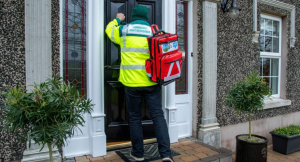
Community First Responder Scheme
What is a Community First Responder (CFR) Scheme?
Community First Responder Schemes are made up of volunteers who live within their local community. The Northern Ireland Ambulance Service (NIAS) alert the volunteers to specific 999 emergency calls in their area and are complementary to the NIAS. Their aim is to reach a potentially life-threatening emergency in the vital first few minutes before the arrival of an ambulance crew. They are able to provide basic emergency life support and use a defibrillator if required. CFRs are alerted in addition to an ambulance, so an ambulance should already be on its way. You can read our Community First Responders leaflet by clicking here.
Why do we need CFRs?
The chance of someone surviving a cardiac arrest (when a person’s heart stops pumping blood around their body and they stop breathing normally) decreases by approximately 10% for every minute that passes without CPR. It is vital to get basic emergency life support to the patient as quickly as possible. CFRs who live in the area can be on scene within minutes and make a real difference before the ambulance arrives. There are around 1500 Out of Hospital Cardiac Arrests (OHCA) in Northern Ireland per year, where resuscitation is attempted, and only 1 in 10 people are likely to survive to see their families again. Due to the rural geography of Northern Ireland, ambulance response times can be delayed, therefore there is an increasing need for local responders to provide early assessment and early intervention until advanced care arrives. CFRs can improve the casualty’s chance of survival by utilising skills in the first three links of the Chain of Survival. For this reason, CFRs play a vital role within their communities and sometimes can be the difference between life and death.
What type of incidents are CFRs alerted to?
CFRs are usually alerted to incidents that are considered to be potentially life-threatening medical emergencies. Examples of calls CFRs are alerted to include:
- people in cardiac arrest—unconscious and not breathing;
- people with chest pain who may be having a heart attack;
- people who are choking;
- people who are unconscious for an unknown reason but are breathing normally;
- people who are potentially suffering from a stroke.
Some CFR Schemes also attend:
- people who are having a seizure;
- people who are having breathing problems.
CFRs are not knowingly alerted to:
- calls where the patient is under 12 years old;
- trauma-related incidents, i.e. road traffic collision;
- calls that present possible hazards such as those involving alcohol, drugs or potential violence;
- calls where the patient is suffering mental health issues.
CFRs use their own vehicles to respond and they must follow the rules of the road with no exemptions. CFRs should never use blue lights or audible/visual warning devices of any description, as it is considered illegal to do so.
Alongside emergency life support, CFRs also play a vital role in the provision of much needed reassurance and support to patients and relatives during very difficult circumstances, which can prove invaluable.
How do CFR Schemes work?
CFR Schemes work in partnership with NIAS to provide timely emergency life support to patients. NIAS does not govern or fund CFR Schemes. NIAS provides:
- Clinical Guidance and Training;
- Support and maintain a scheme;
- Support to alert volunteers & troubleshoot;
- Emotional support (post-incident).
CFR Schemes are set up as independent community groups or charities. The independent charity or community group co-ordinates the CFRs. CFR Schemes will always have a Co-ordinator as a point of contact for the CFR volunteers and to act as a liaison with the Ambulance Service.
What Training is provided?
Training to become a CFR is delivered by the Community Resuscitation Team within NIAS or, with prior agreement can be delivered jointly with appropriately trained personnel from the Scheme. After completing a two day Initial Training course, CFRs will be offered or signposted to relevant additional training. Upon completion of Initial Training it is recommended CFRs will be buddied with a mentor. This will allow them to build confidence by working alongside a more experienced CFR.
Who can become a CFR volunteer?
If you are considering volunteering as a CFR then you must be:
- Physically fit to fulfil the role;
- Have a full driving licence with access to a car;
- Aged 18+;
- Agree to an Enhanced Access NI check;
- Have a sympathetic, caring nature;
- Prepared to undertake initial clinical training and attend update training every 9-12 months;
- Prepared to undertake additional non-clinical training e.g. moving & handling, infection prevention and control, relevant to the role.
Join an existing Scheme
To find out if there is a Scheme where you live, please click Community First Responder Schemes (arcgis.com)
Setting up a new Scheme
Applications for new CFR schemes are currently on hold until further notice. However if you have a query, not answered by the information provided then please contact the Community Resuscitation Team on resus.admin@nias.hscni.net
Additional Information




